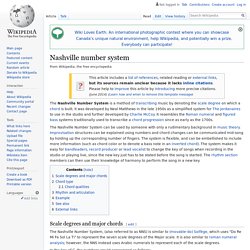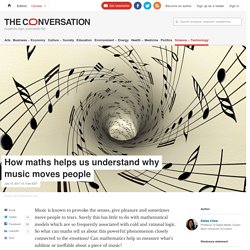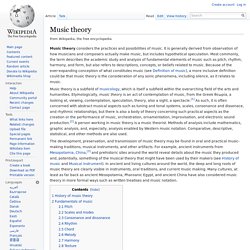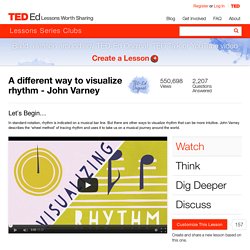

Introduction to Neo-Riemannian Theory. Combinatorial Music Theory. Nashville number system. The Nashville Number System can be used by someone with only a rudimentary background in music theory.

Improvisation structures can be explained using numbers and chord changes can be communicated mid-song by holding up the corresponding number of fingers. The system is flexible, and can be embellished to include more information (such as chord color or to denote a bass note in an inverted chord). The system makes it easy for bandleaders, record producer or lead vocalist to change the key of songs when recording in the studio or playing live, since the new key just has to be stated before the song is started. The rhythm section members can then use their knowledge of harmony to perform the song in a new key. Scale degrees and major chords[edit] The Nashville Number System, (also referred to as NNS) is similar to (movable-do) Solfège, which uses "Do Re Mi Fa Sol La Ti" to represent the seven scale degrees of the Major scale. In the key of C, the numbers would correspond as follows: Play ):
Jacob Collier. Indian Music & theory. Polychords. Rick beato. Wheels. Music Tech Teacher, Music Worksheets, PDF's and Theory Lessons. Youtube. Aimee nolte. Teoria : Music Theory Web. Inside piano. Kent hewitt - jazz piano lessons. Jeff schneider lessons. How maths helps us understand why music moves people. Music is known to provoke the senses, give pleasure and sometimes move people to tears.

Surely this has little to do with mathematical models which are so frequently associated with cold and rational logic. So what can maths tell us about this powerful phenomenon closely connected to the emotions? Can mathematics help us measure what’s sublime or ineffable about a piece of music? Music evokes strong emotions such as frisson (goose bumps), awe and laughter – and has been found to use the same reward pathways as food, drugs and sex to induce pleasure. A shiver down one’s spine or an uncontrollable guffaw when listening to music is most often a case of the music defying your expectations.
On one end of the spectrum, a performance or a piece of music that does just what you’d expect runs the risk of becoming banal. Author provided Listen PDQ Bach: The Short-tempered Clavier: Minuet in C Download MP3 / 735 KB Playing with expectations Listen Happy Birthday (first part) Download MP3 / 284 KB. Funana presentations. Teoria : Music Theory Web.
The Basics of Musical Pitch. Progressions. Music theory. Music theory considers the practices and possibilities of music.

It is generally derived from observation of how musicians and composers actually make music, but includes hypothetical speculation. Most commonly, the term describes the academic study and analysis of fundamental elements of music such as pitch, rhythm, harmony, and form, but also refers to descriptions, concepts, or beliefs related to music. Jazz theory. Harmonic theory.
A different way to visualize rhythm - John Varney. To learn more on circular perceptions of rhythm with specific reference to African music, read this paper and then watch this Five(ish) Minute Drum Lesson on African Drumming.

How has drumming played an essential role in African culture? What do specific rhythms represent? Interested in the software applications of a circular rhythmic approach? What are the pros of representing rhythm with a circular representation as opposed to using a more traditional linear representation? This article will help you learn more. What exactly is rhythm? How does the beat of a song differ from its rhythm? As seen from this TED Ed lesson, different cultures share similar rhythms. Rhythm and Math are related? Utilities.
Music Theory for Musicians and Normal People. By Toby W. Rush This page includes links to each of the individual Music Theory pages I've created in PDF form. This is a work in progress; I am writing new ones regularly and fixing errors and omissions on existing ones as I find them. If you find them useful for your theory studies, you are welcome to use them, and if you find errors or have suggestions, I invite you to contact me.
Enjoy! Click the thumbnails to view or download each page as a PDF for free! These pages are available for free under a Creative Commons BY-NC-ND license. This collection is a work in progress, but if you would prefer, you can download all the current pages as a single PDF. Each and every one of these pages is available is an 18" x 24" poster. These pages are available in multiple translations and localizations!
Tymoczko_chords2006.pdf. Some Interesting Keyboards. Some books about music refer to a persistent "myth" that it is possible, using only two keyboards, to construct an instrument on which it is possible to play music in any key using just intonation.

Indeed, it is true that it is not possible, with only 24 keys to the octave, to construct an instrument that will play in perfect just intonation in every key. However, it is possible to exhibit an example of the type of keyboard that has given rise to this "myth", so that its capabilities, as well as its limitations, can be seen. Thus, what may be constructed with 24 keys to the octave is a keyboard which allows playing diatonic music in just intonation in any of the twelve conventionally designated keys, even if nothing can be ensured concerning the pitch of accidentals, and with the provision that one has to make a jump in pitch when one transposes around the far end of the circle of fifths.
This will be shown explicitly below. The most obvious design: This is the Wicki-Hayden keyboard.
Teoria Musical. Music Theory. Just and other tunings. Music Tools. Geometry of harmony. Chords. Mmmusic. The Essential Secrets of Songwriting Blog.